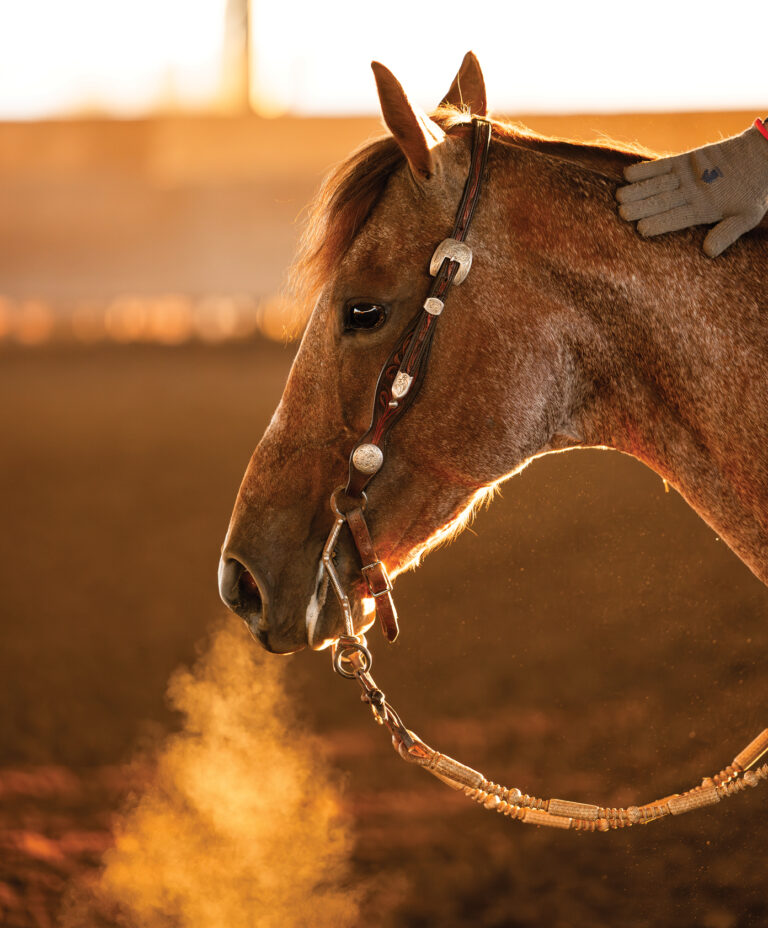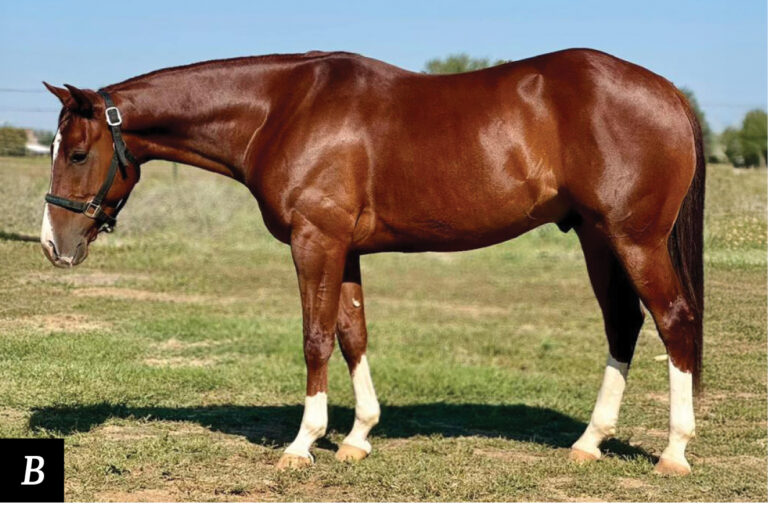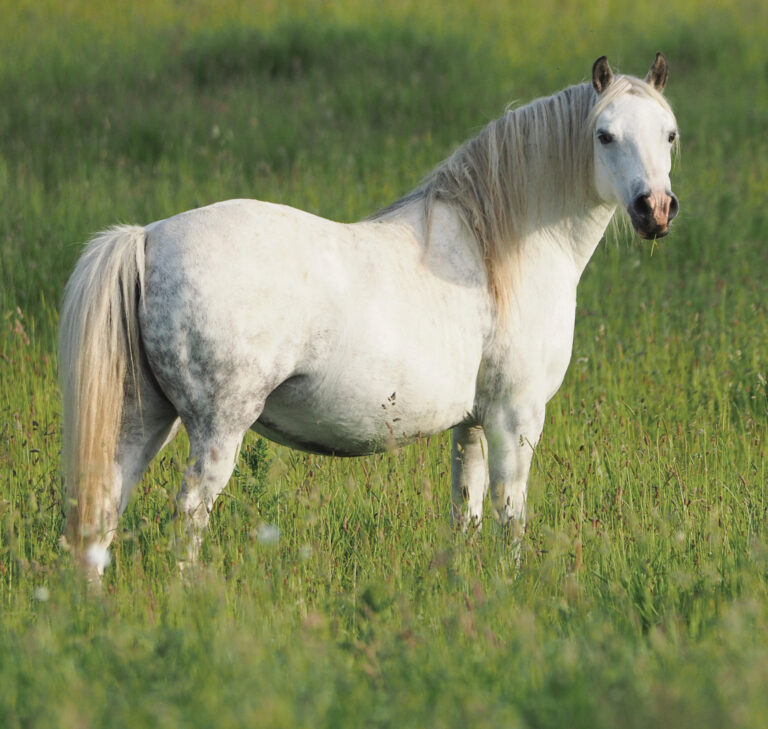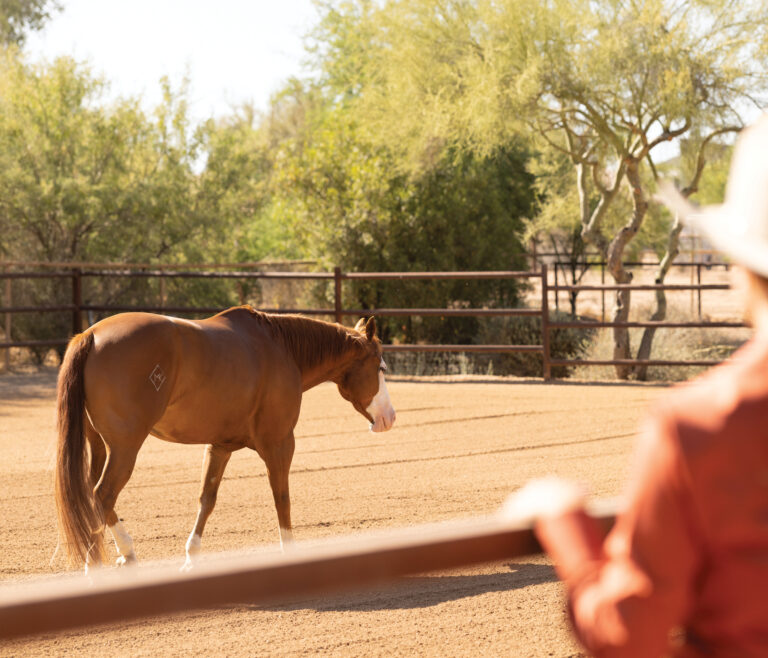There’s a scene in the famous movie Seabiscuit where trainer Tom Smith is tending to an injured horse, and says, “You don’t throw away a whole life, just because he’s banged up a little.” When Looking Rey, aka ‘Leroy,’ entered the lives of Mike and Kris Stevens they didn’t know what lay in store. As Leroy’s journey started to unfold, his owners and team embodied the meaning of that quote, doing everything in their power to give Leroy what he needed, and let the horse see through a lens of his own. Literally.
Welcome Home
Standing 15.1 hands, Leroy is a stout, handsome horse. The 9-year-old Quarter Horse gelding was purchased by Mike and Kris as a late 5-year-old. The Stevens have been in the sport of cutting for decades and know a talented horse when they see one. Leroy was no exception.
The gelding was already trained and competing, and when he joined Mike and Kris at their home, they knew he would need time to settle in. However, Mike notes that he was particularly head shy, tended to pull back at odd times, and was quite reactive to standing in water and wet shiny surfaces. “In our experience, a new arrival would get over this sort of thing in a couple of weeks,” shares Mike Stevens. “But not Leroy.”
As Leroy continued to display odd or reactive behavior, the Stevens remained patient, expecting he would eventually settle in.
At the First Sign of Trouble
Six months after Leroy arrived at Mike and Kris’ barn, his left eye unexpectedly swelled and became painful. Suddenly, the couple knew that Leroy might have an underlying cause for his strange behavior. Mike expressed their lightbulb moment saying, “This event started a process that ultimately changed our initial impressions regarding his behavior.”
From here, the real journey would begin. The Stevens are experienced horse owners and are proactive about their care. They immediately dialed their vet’s number. After an initial examination, there wasn’t an apparent reason for Leroy’s irritated eye. There was no sign of debris or laceration, and the team was left without answers.
Ruling out fly issues was an easy step.
“We have a very good fly control program in our stable, and we maintain exceptionally high standards for cleanliness and dust control in the barn,” Mike says. “This made fly- or dust related causes for the inflammation less likely. Our vet assumed that the cause might be early-stage conjunctivitis and we began a treatment protocol appropriate to that diagnosis.”
Search for Answers
After three weeks, Leroy’s condition didn’t improve. Mike and Kris were determined to find answers. This is when they decided to contact a doctor who specializes in veterinary ophthalmology.
Dr. Norman is a veterinary ophthalmologist, a board-certified veterinarian specializing in the management of medical and surgical disease of the eye and vision. The primary goal of a veterinary ophthalmologist is to preserve the comfort and vision of the patients they treat.
“We are first doctors of veterinary medicine but then go on for at least a year of rotating internship training and then complete a three-year residency in veterinary comparative ophthalmology,” Dr. Norman shares when talking about the training she received. “To be considered diplomates of the American College of Veterinary Medicine we then need to pass our rigorous board examination.”
Veterinary ophthalmologists all treat cats and dogs, and a handful are also trained to work with equines. Dr. Norman happens to be one of that handful.
When Dr. Norman met Leroy, she found a sweet, patient gelding who presented with nonspecific and periodic squinting, tearing, and swelling of the left eye. Dr. Norman examined Leroy carefully and came up with a conclusion: Leroy was suffering from subtle but active uveitis, or inflammation within the left eye.

Understanding Uveitis
Understanding uveitis was the first step for the Stevens to be able to provide Leroy with the care he needed.
Uveitis is a condition that affects the eye and can ultimately lead to loss of vision if left untreated or allowed to progress.
“Internal inflammation may affect the front of the eye (anterior uveitis) or back of the eye (posterior uveitis) or both,” Dr. Norman shares. “The condition can simply be uncomfortable, or it can cause significant discomfort and pain.”
Oftentimes, poor behavior in horses is attributed to lack of manners, lack of training, or simply a bad attitude. Oftentimes, it’s much deeper than that. Mike and Kris knew that there was a deeper meaning to Leroy’s quirks and didn’t stop until they had the answer.
Dr. Norman expands on the symptoms that one might see with a horse suffering from uveitis. “Symptoms can include squinting, tearing, redness, or a cloudy look to the eye. Periocular [around the eye] swelling may develop,” says Dr. Norman. “The pupil may be very small, and the iris may have color changes over time. Vision changes may be obvious if spooking or hesitancy is evident.”
On the surface, Leroy’s reactive behavior might have looked like a case of ill-manners. His diagnosis of uveitis confirmed that Leroy was reacting to the pain in his eye. His behavior was a symptom of pain, not behavior for behavior’s sake.
Mike notes that out of the two kinds of uveitis that affect horses—the one-time kind, and the recurrent kind—Leroy has Equine Recurrent Uveitis (ERU). This means that Leroy most likely suffered the root cause of his uveitis years before he came into the care of the Stevens.
Leroy’s Treatment
After his diagnosis, Dr. Norman started a treatment plan. Leroy was to be treated with a medicated ointment daily for two weeks, and then twice a week for the remainder of his days. Treatment doesn’t always mean a cure, though, according to Dr. Norman, “The goal is suppression and control of inflammation—not a cure.”
Mike and Kris were enthusiastic about starting this treatment, hoping it would bring the gelding some relief. However, putting ointment in the eye of a large animal is as tricky as it sounds. Mike and Kris persisted.
“Leroy is a big, strong, energetic kid. Combining his size and demeanor with a sore swollen eye made inserting the ointment in the initial period rather challenging,” Mike says. “With determination we got it done.”
Seeing Improvements
Then, something wonderful happened. As the couple continued the treatment, Leroy seemed to feel better. His attitude towards the ointment improved, the swelling was reduced, and according to Mike, near the end of the 14 initial period he was almost sticking his eye on Mike’s finger to receive his daily treatment.
Mike quickly became Leroy’s favorite human as he was the bringer of relief, and he started to show marked signs of improvement. Dr. Norman confirmed that the flare-up had receded, and Leroy’s uveitis was in a mild state. At this point, the team started discussing long-term treatment and eye protection for Leroy.

After some trial and error, Dr. Norman and the Stevens landed on a plan that keeps Leroy comfortable at home.
“We use a lightweight 75% UV protected fly mask for him during daylight hours in the stable and a 90% UV reducing fly mask for turnout,” Mike shares. “Combining his bi-weekly ointment treatments with this mask protocol has kept his left eye uveitis in remission for about two years now.”
After a year of successful treatment, Leroy faced another setback. This time a flare up in his right eye. Another exam with Dr. Norman confirmed uveitis in both eyes. It was also discovered that Leroy had a cataract in this right eye.
A Cut Above
Leroy came to the Stevens proven in cutting, and more than familiar with the show pen. Mike and Kris knew that despite his condition, he had a bright future in the sport, and were determined to give him the tools needed to shine.
The odd behavior that Leroy had displayed started to subside. As his treatment continued, and the inflammation receded, the Stevens also noticed his behavior improving rapidly.
The improvements were noticed under saddle, as well. Leroy became more cooperative, more willing to work, and most importantly started to trust the people he was around.
As Leroy made his way back into the cutting pen, he required gear specific for the arena.
“When the patients are flaring, they are light sensitive,” Dr. Norman shares. “Some remain that way in the brightest light conditions.”
The bright lights of an arena, the glare from the sun entering through open sides, or competing outdoors in direct Arizona sunlight meant Leroy needed some special eyewear. Katie
Peterson, a family friend of the Stevens’, came up with the idea of fitting Leroy for his own, special goggles. She procured the first pair as an experiment, and Mike and Kris introduced Leroy to the same kind of goggles commonly used by three-day eventers in cross-country disciplines. Leroy took to them like he’d worn them his entire life.
Time to Show
Once he had the right gear that minimized the pain caused from the uveitis, Leroy was ready to rock. Mike Stevens knew that after getting the horse comfortable, it was time for Leroy to shine.
“Leroy is an accomplished cutting horse,” Mike explains. “He enjoys working with cattle, and he loves the show arena. Getting his uveitis under sufficient control to eliminate pain and discomfort improved his demeanor and focus when being shown.”
As if Leroy wasn’t already surrounded by the best people for his journey, Al Dunning then came on the scene.
Armed with a new attitude, a relief from the pain, and flashy eyewear, Leroy was ready to hit the arena. Dunning began working with him, and Marilyn Brandt, Dunning’s assistant, stepped in to provide care and attention to Leroy while the gelding was in their stead. Brandt, an accomplished horsewoman herself, cares for Leroy, doctoring him and ensuring he has his goggles. Dunning and Brandt have been competing on the gelding, along with Mike, and Leroy is thriving. As with the rest of his team, Dunning was taken with the horse, saying “He’s strong, handsome, and a big-moving son-of-a-gun. He’s quite the horse.”
You Don’t Throw a Whole Life Away
A gelding in goggles isn’t a common sight in cutting, but Leroy wears them with pride. The Stevens’ even think that he might strut a little bit more when he has them on. They’ve become a staple part of Leroy’s wardrobe, and Mike knows that the goggles provide the gelding with relief from the glare and sun.
“We believe the goggles have reduced sensitivity to glare and help him to see and read a cow better in the show arena,” Mike shares. “We use the goggles on him for all outdoor riding or practicing.”
Dr. Norman also specifies that the goggles don’t offer a competitive advantage, as they do not serve as blinders.
The journey isn’t finished in terms of long-term care. Mike and Kris know that the prognosis for uveitis can mean diminishing vision over time. Their main concern? Extend that time for as long as possible.
Managing Daily Life
They understand their efforts don’t mean that Leroy is out of the woods.
“The goggles are one part of what we’re doing to address his ERU. We know that no cure exists and the best we can hope for is a state of remission,” Mike says.
Knowing that sunlight cause sensitivity, all of Leroy’s team ensure he has goggles or a mask on at all times when in sunlight.
This story is about so much more than a cutting horse wearing goggles, though. Leroy’s condition is one that can oftentimes present as simple behavior problems. His odd behavior when joining the Steven’s family and his unwillingness to settle in was the first red flag.
However, if Mike and Kris hadn’t been the vigilant and caring horse owners that they are, Leroy’s behavior might have been attributed to simply a bad attitude.
Owners That Care
Al Dunning spoke highly not only of the sorrel gelding, but also of Mike and Kris. He noted that they’re the kind of people who would do anything the horse needs.
“It is a wonderful thing to encounter folks that will do what it takes to not just improve a horse’s career—but his livelihood,” Dunning says.
Mike and Kris Stevens certainly don’t expect praise or admiration for the lengths they will go to for their horses. For them, it’s just part of being a responsible horse owner. But there is a handsome, sorrel gelding that received a new lease on life thanks to their persistence, patience, and care. A horse that was suffering in silence, unable to ask for help beyond his actions, that came into the care of a couple that decoded his behavior and found a solution.
Leroy’s humans are the epitome of the quote, “You don’t throw away a whole life, just because he’s banged up a little.” Their key interest is the well-being of their horses and allowing them to have the best quality of life they can have.
Mike Stevens sums it up nicely, “The one certainty of life is that no living thing survives it. The goal is to live this life, each day, as well as you can. Leroy is a fun horse to be around, to ride and a riot to show. We enjoy each other. Life is good.”




